Expedition to the ancestors: a stopover or agro-revolution on the ground

Still from the film “One Million Years BC” (1966). A more cultured woman treats Tumak to a vegetable from the garden! It could be so, and why not?
first the greens, then the ear,
then the full grain in the ear.”
Mark Gospel 4:28
Is it really not clear that your house is a prison,
And they take you for a lackey?
And I... I walk on the rooftops by myself,
And I don’t know how to lick hands.
Yes, you can follow the bear's trail,
Participate in a fight.
I’m sorry, but you won’t see freedom!” –
That's what the Cat said to the Dog!
Author: Maid of the Mist
Migrants and migrations. The main direction of the articles in our series is the story about the fate of Homo Iter, that is, the “traveling man,” because throughout his ancient history, as we have already seen, all he did was move from one region to another, from continent to continent. However, this path “was not easy and uneasy.” And although our ancestors walked forward during the day, and perhaps even at night, their journey took not years, or even centuries, but whole thousands of years, during which, by the way, many neoanthropes and even the same Neanderthals lived in the same places.
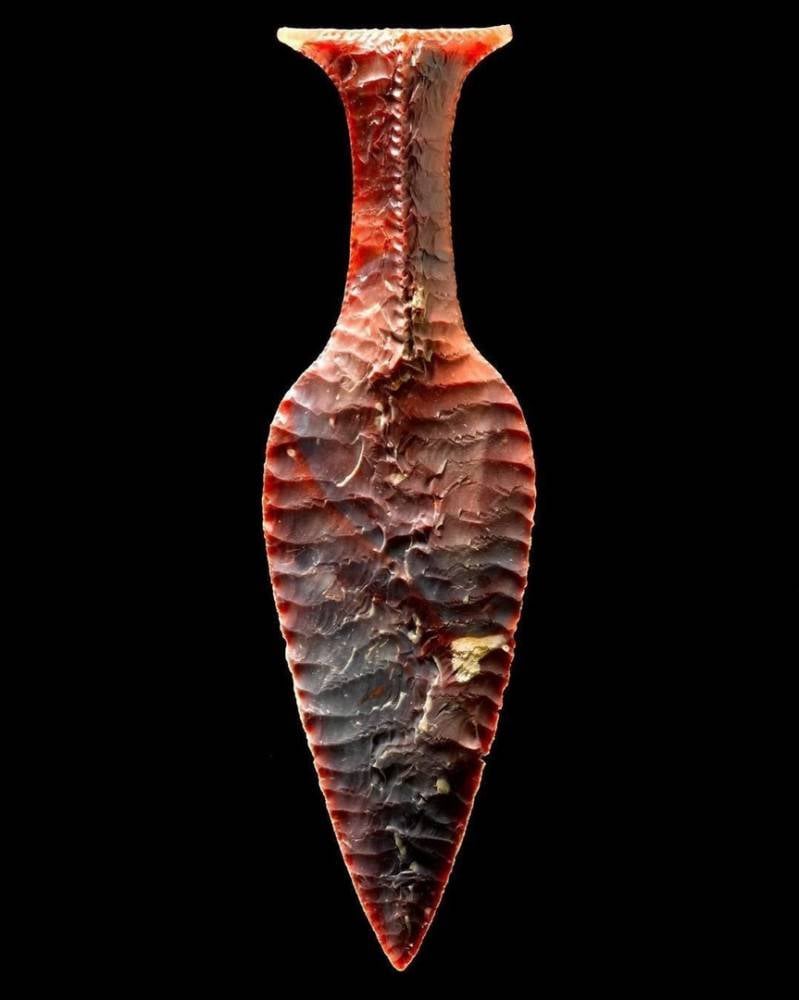
Stone knife from Denmark. It was very difficult to make one, but our ancestors learned how to make such knives! National Museum of Denmark, Copenhagen
Less dependency, more people!
But living in the same places, people experienced difficulties in obtaining game, which became frightened, or even left the places where it was intensively exterminated. The transition from gathering and hunting to agriculture helped cope with the emerging problem of food shortages, and at the same time it changed humanity itself. But this required domestication (i.e. domestication) of plants and animals in limited areas. The oldest traces of agriculture, dating back 10 years, were discovered by archaeologists in the Levant, and from there it spread to Europe, North Africa and Central Asia.

I wonder if women of that time were as warlike as shown in “A Million Years...”. And yet... how covered were they with clothing?
In the 150 years preceding the “agro-revolution,” neoanthropes, who had previously lived on pasture, populated almost the entire planet, regularly making seasonal migrations in search of prey. But since they wandered on foot, mothers carried their children on themselves, while a woman could neither feed nor carry more than one child. Therefore, “extra” children may have even been killed. Therefore, human population growth remained low for millennia. But having learned to breed certain species of animals and plants, humanity began to depend less on many random factors of the nature surrounding them, replacing this complex dependence with a simpler one - on only a few representatives of flora and fauna.
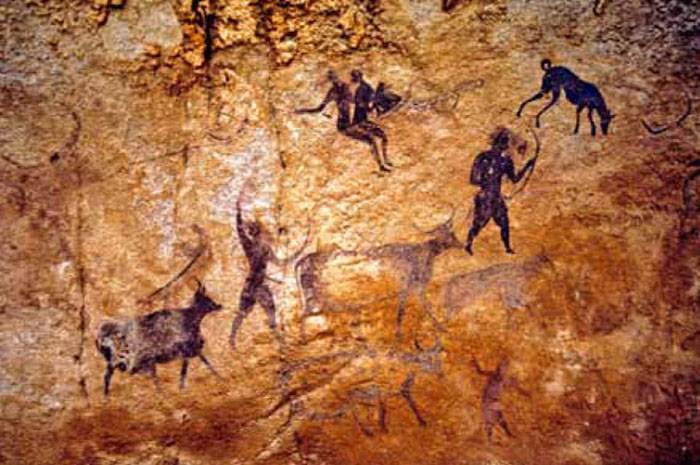
Rock art of Tassilin-Adjer (North Africa), VI thousand years BC. e. Cows and a dog with a crochet tail!
From gathering to sowing
By the XNUMXth millennium BC. e. some groups of neoanthropes switched to sedentary life in fertile areas. There was enough food there all year round, and as a result the population began to increase at a rapid pace. This forced the transition to agriculture, which made it possible, through only a slight additional increase in labor costs, to obtain significantly more food products per unit area. Settlement, population growth and dependence on agriculture immediately led to an increase in the number and size of settlements, collectively contributing to the development of more complex social relations, the emergence of classes, and ultimately cities and civilization.
The oldest traces of agriculture are the remains of wild species, only slightly modified by human intervention. It is known that the first food crops were grains and legumes, the seeds of which are rich in nutrients such as carbohydrates and proteins. And besides, they are also easy to store and germinate after sowing.
Agricultural polyculturism: where did it come from?
If scientists are still arguing about whether Homo sapiens (or his ancestors) appeared in one place or in several, then with regard to agricultural crops it is known for sure that they originate from several centers of domestication. What they have in common is only the thermal regime, that is, the presence of natural climatic conditions convenient for farming.
Thus, Southwestern and Central Asia gave humanity wheat, rye, barley, oats, lentils and peas (regular and Turkish), as well as radishes, carrots and parsnips. Here, apple, pear, date palm, fig, grape, and olive were domesticated.
From Southeast Asia it received rice, soybeans and mung beans, as well as taro and yams. Apricots, bananas, citrus fruits, mangoes, coconuts, sago, eggplant and tea all come from China. Or rather, from the territory that is China today, and again, from Southeast Asia.
Tropical Africa is sorghum, millet and cowpeas (and also pigeon peas), oil palm, sesame, coffee, tamarind and watermelon.
Mexico is corn and beans, as well as red peppers, pumpkins, tomatoes and avocados.
In many regions, root crops now play an important food role, for example, in the temperate zone - these are potatoes that were once cultivated in the Andes, and in the tropics - cassava (cassava), yams, sweet potatoes and taro, which also come from there.
The north of South America gave humanity guava and pineapple, cashews, cocoa, peanuts and quinoa.
And India became the homeland of cucumbers, where their non-domesticated relatives still feel great there.
Even Europe, which is cool in terms of climate (though the south and the Mediterranean region) can boast that it has also sufficiently enriched the agricultural culture of Homo sapiens. The same carrots, turnips, beets, radishes, peas and flax became domestic plants here.
The revolution has a beginning, but no... end!
Archaeological evidence suggests that the agricultural revolution began about 10 years ago, that is, during the Neolithic era in the so-called “fertile crescent” region of Southwest Asia. Charred seeds and chaff of barley, wheat, various legumes, as well as bones of domestic goats and sheep are found here. Moreover, judging by radiocarbon dating, agriculture arose approximately 000 years earlier than cattle breeding.
Agriculture spread gradually, paralleling the growth of settlements, the development of irrigation and terracing methods, and the introduction of fruit crops, in particular the date palm, figs, grapes and olives. By the end of the Western Asian Neolithic (ca. 6 years ago), agriculture began to be practiced in Europe, North Africa, Central and South Asia.
In China it appeared in the period from 9000–8000 BC. e., in America - approx. 5 years ago and Tropical Africa - 000 years ago. By the start of global European expansion in the 4th century, agriculture and pastoralism fed Eurasia, Africa, and Central and South America. That is, the selection of domestic plants continued for a very long time. It hasn't ended today...
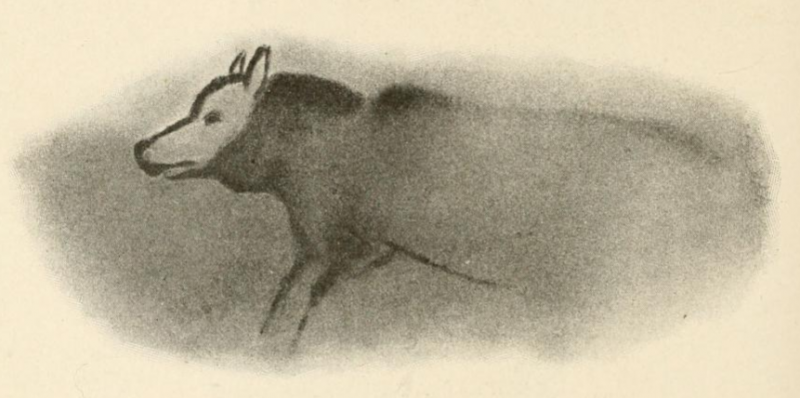
Watercolor copy of a cave painting of a wolf-like dog, Font de Gosme cave, France. The drawing is 19 years old. Watercolor painted in 000 by archaeologist Henri Breuil
In line for domestication...
Plants were domesticated on all inhabited continents except Australia (farming arrived there with European colonists in the XNUMXth century), but animals were domesticated primarily in Western Asia, where people first acquired sheep, goats, pigs and cows, and later donkeys and camels. . Pigs and cattle were also domesticated independently in South and East Asia, where humans first introduced chickens.
They began to raise cows and pigs on their own in Europe; In the southern Russian steppes, a horse was tamed for the first time, which became an event of paramount importance. But few domestic animals appeared in the New World: in North America it was the turkey, and in the South it was the llama and alpaca. But in Africa and Australia there were no animals suitable for domestication at all.
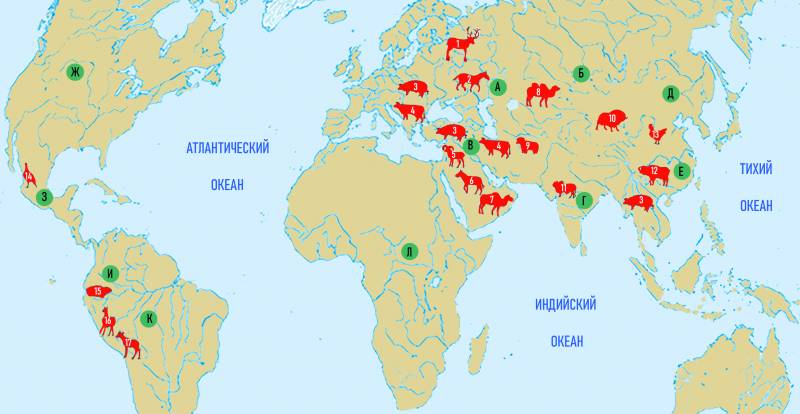
Animal domestication map:
A – southwestern steppes of Eurasia, B – Central Asia, C – Southwest Asia, D – Indus Valley, E – China and Southeast Asia, F – Southeast Asia, G – North America, W – Mexico, I – northern part of South America, K – region of the high Andes, L – Central Africa;
1 – reindeer, 2 – horse, 3 – pig, 4 – cow, 5 – goat, 6 – donkey, 7 – dromedary camel, 8 – Bactrian camel, 9 – sheep, 10 – yak, 11 – zebu, 12 – buffalo, 13 – chicken, 14 – turkey, 15 – guinea pig, 16 – llama, 17 – alpaca. Rice. A. Shepsa
But the first was a dog!
But the question is, which animal was the first to be domesticated?
And the answer to it will be truly surprising, although quite logical - not a pig, not a cow or a sheep, but... a dog! Fossil remains of domesticated dogs have been found in Siberia, and the age of a domestic dog from the Altai Razboinichya cave, discovered back in 1975, is estimated at 33,5–34 thousand years.
The remains of ancient dogs were also found in the Czech Republic (Předmosti). Here their age dates back to 24–27 thousand years BC. e., in Ukraine - 15 thousand years BC. e., in America, Utah - 11 thousand years BC. e., China - 7–5,8 thousand years BC. e. Moreover, there are the remains of a dog buried next to people - this is the Bonn-Oberkassel dog, age 14 years.
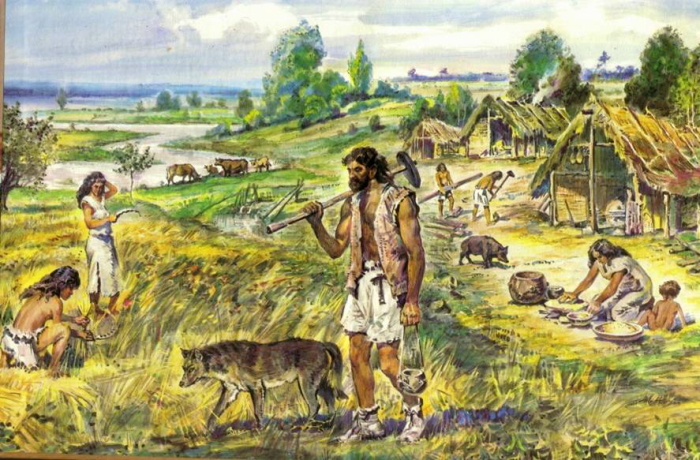
Site of Neolithic people. Illustration from a textbook on the history of the Ancient World for grade 5. 60–70 last century
Tells the dog's menu...
Interestingly, a study of the mitochondrial DNA of the oldest domestic dog in America (from Alaska) aged 10-15 thousand years old showed that its ancestors separated from other dogs about 16,7 thousand years ago.
It turned out that during its lifetime this dog ate fish and the meat and bones of seals and whales. That is, this confirms the hypothesis that the first migration of people and dogs to America took the northwest Pacific coastal route, and not along the central continental corridor between the glaciers.
Big and furry...
What were they like, the first domestic dogs? First of all, let's say that the structure of the skull of prehistoric dogs was very different from prehistoric wolves. In addition, prehistoric dogs were large and most likely furry. The dog is considered the first animal that man managed to domesticate.
But further in the history of the relationship between man and dog, everything is covered in “dark darkness.” True, it is believed that dogs took the first step towards getting closer to humans. They ate scraps at the sites of primitive people, gnawed bones, and accompanied people on hunts. And people realized that dogs were useful to them and began to breed them on purpose, discarding the stupid and noisy ones, preserving the lives of the smart and obedient ones.
The benefits of dogs for primitive hunters were obvious: they helped hunt, guarded camps, on cold nights dogs slept with people and warmed our ancestors, however, primitive people sometimes ate prehistoric dogs. And people appreciated dogs already in that distant time, as evidenced by the burials of dogs, and they were often buried with their owner.
In 2020, it was proven that modern wolves and dogs have different genetic lines and, therefore, are not relatives, which means they came from different ancestors. It is possible that the dog's ancestor was a Pleistocene wolf, which later became extinct.

Well, just a very wild domestic cat! It is believed that the desire to chase a running mouse is inherent in a cat at the genetic level. https://pets-expert.ru
It wasn't cats that got people interested, it was cat people!
In the same area of the “fertile crescent” and also “not on the move”, but already during sedentary life, the domestication of the cat took place. For a long time it was believed that cats were domesticated in Egypt 5-6 thousand years ago. But in 2004, French archaeologist Jean Denis Vigne found a human grave on the island of Crete dating back to the 10th–XNUMXth millennium BC, and half a meter away from it another grave of a kitten. But cats did not live on the islands of the Mediterranean Sea, which means that humans brought cats to Crete, and that cats were domesticated more than XNUMX thousand years ago.
Today it is believed that approximately 10,5 thousand years ago, representatives of the cat tribe began to bring tangible benefits to people, primarily in the lands of Palestine. They began hunting mice that bred near the granaries, and thereby attracted the attention of the inhabitants of the local settlements. They began to feed the cats and lure them to the houses, and children played with the kittens. This is how cats were gradually and imperceptibly tamed, although elements of savagery are still preserved in them. Cats do not depend on humans when choosing a mate, they are excellent at getting their own food and are able to survive in a wide variety of weather conditions.
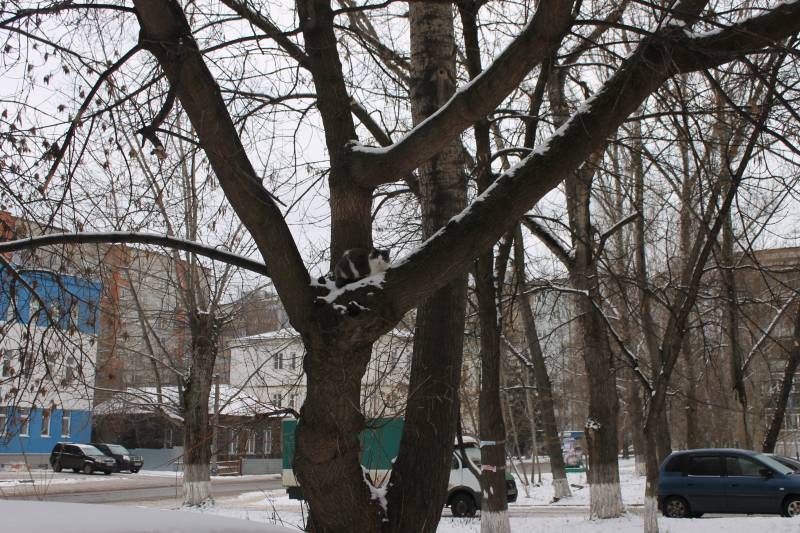
Even a modern cat can spend a whole day in a tree in winter, only occasionally going down to the grocery store to ask compassionate people for food. And you can be sure that the kitty will get hers!
Nevertheless, in ancient times cats were highly valued. In the same Egypt, a cat turned into the goddess of joy, love and fun Bastet, dead cats were mummified, and the death penalty was imposed for killing a cat! Cats were forbidden to be taken out of Egypt, but apparently they were taken out anyway.
In addition, they also came to Europe from other places, for example, from Western Asia, so that already 2 thousand years ago they were widespread here.
To be continued ...
Information